Marvellous Mauve
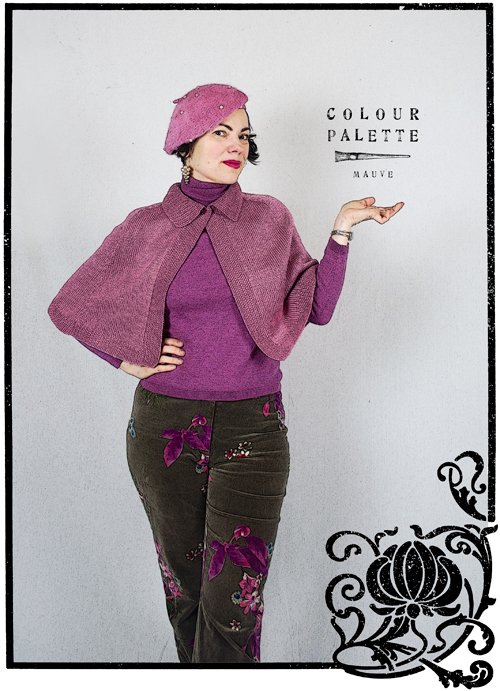 A couple of years ago I wrote a story about different shades of purple, and I touched on the discovery of the first aniline dye in 1856 that became known as mauve, the French word for mallow flower after which the colour is named. Originally it was probably a darker shade than contemporary notions of it, as it was first likened to Tyrian purple which is much darker. The first mauve dye was replaced with other synthetic dyes in 1873: a lighter, less-saturated shade that we are familiar with today. As Wikipedia succinctly describes it, ‘mauve contains more grey and more blue than a pale tint of magenta’.
A couple of years ago I wrote a story about different shades of purple, and I touched on the discovery of the first aniline dye in 1856 that became known as mauve, the French word for mallow flower after which the colour is named. Originally it was probably a darker shade than contemporary notions of it, as it was first likened to Tyrian purple which is much darker. The first mauve dye was replaced with other synthetic dyes in 1873: a lighter, less-saturated shade that we are familiar with today. As Wikipedia succinctly describes it, ‘mauve contains more grey and more blue than a pale tint of magenta’.
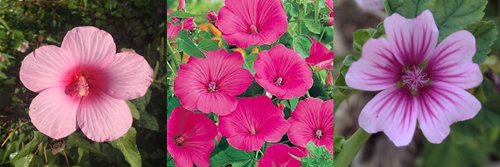 Three shades of mallow flowersHowever, while it was a synthetic dye, in the 1850s it was still quite expensive to process, and if not for Empress Eugénie, wife of Napoleon III, taking a liking to it because it supposedly exactly matched her ‘violet’ eyes, the colour might have disappeared. Queen Victoria subsequently gave it the thumbs-up, and for a time it was all the rage, reaching its heights of popularity in the 1890s.
Three shades of mallow flowersHowever, while it was a synthetic dye, in the 1850s it was still quite expensive to process, and if not for Empress Eugénie, wife of Napoleon III, taking a liking to it because it supposedly exactly matched her ‘violet’ eyes, the colour might have disappeared. Queen Victoria subsequently gave it the thumbs-up, and for a time it was all the rage, reaching its heights of popularity in the 1890s.
… for a time it was all the rage, reaching its heights of popularity in the 1890s
As with many trends, however, it soon reached over-saturation in the market and eventually it became passé, synonymous with ladies of a certain age. Even in the twentieth century, it was associated with aging, as it was one of the shades white-haired ladies chose to rinse their hair with to remove unlikable yellowish tones. Today of course that trend has been turned on its head and grey hair tinted with pastel shades is all the rage with young people!
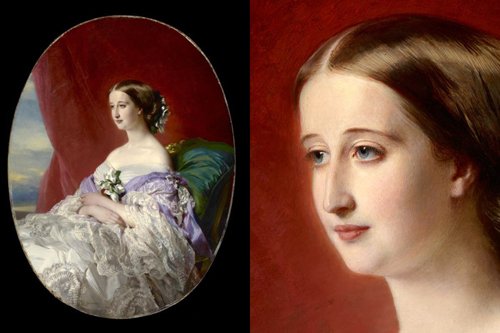 Empress Eugenie, 1854, by Franz Xaver Winterhalter – Franz clearly thought, "Pfft, purple eyes, MY EYE!"
Empress Eugenie, 1854, by Franz Xaver Winterhalter – Franz clearly thought, "Pfft, purple eyes, MY EYE!"
Wait, what about the purple eyes?
I was interested in this notion of the Empress’s supposed violet eyes, and some research lead me to learn that Elizabeth Taylor was another celebrity famed for her violet eyes. Paintings are not necessarily true to life, and photographic evidence is obviously unreliable as it is too easy to digitally enhance hues or use colour filters in-camera.
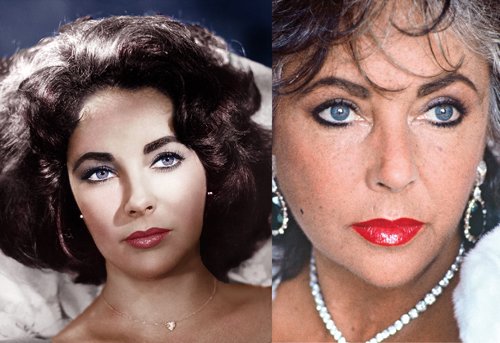 Elizabeth Taylor in 1960 (ph unknown) and 1985 (ph Helmut Newton); she definitely seems to have naturally blue eyes that have been enhanced by the colour processing in the first photoAfter a lot of reading, I can state definitely that the human eye does not naturally come in shades of purple; ie people cannot be born with it. Put simply, the colour of an iris changes depending on how much light reaches it, and can be enhanced by coloured clothing or makeup surrounding the eyes; both Empress Eugénie and Elizabeth Taylor had blue eyes: one wore purple garments, the other purple eyeshadow. [See Further Reading below]
Elizabeth Taylor in 1960 (ph unknown) and 1985 (ph Helmut Newton); she definitely seems to have naturally blue eyes that have been enhanced by the colour processing in the first photoAfter a lot of reading, I can state definitely that the human eye does not naturally come in shades of purple; ie people cannot be born with it. Put simply, the colour of an iris changes depending on how much light reaches it, and can be enhanced by coloured clothing or makeup surrounding the eyes; both Empress Eugénie and Elizabeth Taylor had blue eyes: one wore purple garments, the other purple eyeshadow. [See Further Reading below]

Back to fashion …
Since my original story, I have since found new mauve items in differing shades all from thrift stores: a merino wool jumper, a prettily hand-knitted vintage wool cape, and a vintage angora, pearl-beaded beret. The jumper is modern, but I am not sure of the age of the latter two; the beret was missing pearls when I bought it, but the cape is pristine and could be a modern knit made using a vintage pattern. My printed velvet pants are modern, by the Australian label Charlie Brown.
Scroll down and check out some more mauve outfits from the Victorian era to the present.
Further Reading
The biology behind eye colour in humans
Were Elizabeth Taylor’s eyes really violet?
But wait, Liz Taylor had double eyelashes!
Just how did Lizzie make her blue eyes look purple?
Photos: August 2019
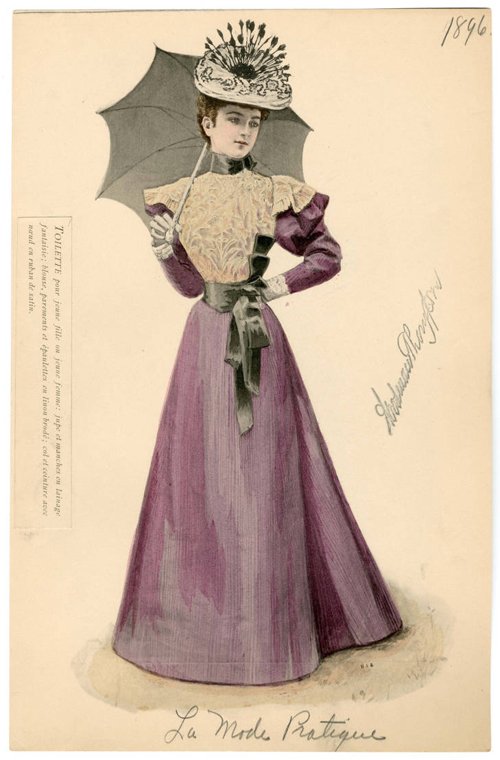 Victorian walking dress, 1896
Victorian walking dress, 1896 Victorian evening dress, 1896
Victorian evening dress, 1896 Victorian silk striped walking dress
Victorian silk striped walking dress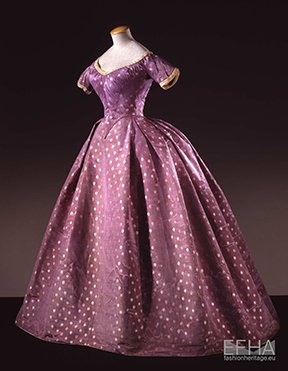 Silk taffeta evening dress, 1860-1865
Silk taffeta evening dress, 1860-1865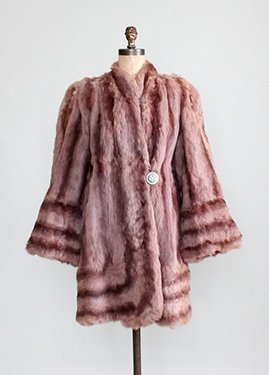 1930s fur jacket (sold)
1930s fur jacket (sold) 1930s bias gown (for sale)
1930s bias gown (for sale) 1940s catalogue – how I would love to buy this set, especially at those prices!
1940s catalogue – how I would love to buy this set, especially at those prices! Model Evelyn Tripp, wearing a dress and matching hat, ph Frances McLaughlin-Gill for Vogue
Model Evelyn Tripp, wearing a dress and matching hat, ph Frances McLaughlin-Gill for Vogue Modern outfit
Modern outfit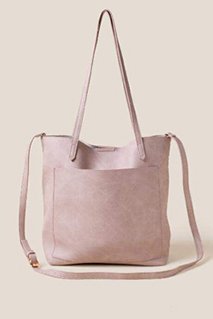 Rosie tote in mauve
Rosie tote in mauve

